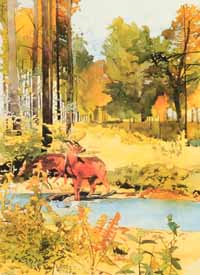
 |
Artist's illustration of an early Holocene environment. | |
|
Following the Ice Age, Illinois' landscape was transformed by deciduous forests and eventually, the development of vast prairies. Changes in vegetation prompted changes in the type and number of animals. Here we see white-tailed deer (Odocoileus virginianus) in an opening of the forest. |
||
The complicated interactions between the earth’s atmosphere and its oceans that resulted in the Ice Age came to an end about 12,000 years ago. The next chapter of earth history is known as the Holocene or Recent period. During the Holocene, Illinois’s climate has not been constant. Periods of increased precipitation and cooler temperatures contrast with warmer periods with less precipitation. Shifts in temperature and precipitation influenced the type and distribution of plants and animals. The most dramatic sequence of events resulted in the widespread growth of prairie vegetation, which replaced forests on the flat upland topography of Illinois. Changes in environment presented new challenges to Native Americans, and the Archaic Period of Illinois history was a time of change in Native American culture.
|
|
Copyright © 2000 Illinois State Museum